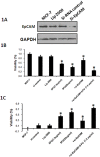Knockdown of EpCAM enhances the chemosensitivity of breast cancer cells to 5-fluorouracil by downregulating the antiapoptotic factor Bcl-2
- PMID: 25019346
- PMCID: PMC4097402
- DOI: 10.1371/journal.pone.0102590
Knockdown of EpCAM enhances the chemosensitivity of breast cancer cells to 5-fluorouracil by downregulating the antiapoptotic factor Bcl-2
Abstract
Resistance to fluoropyrimidine-based chemotherapy is the main reason for the failure of cancer treatment, and drug resistance is associated with an inability of tumor cells to undergo apoptosis in response to treatment. Alterations in the expression of epithelial cell adhesion molecule (EpCAM) affect the sensitivity or resistance of tumor cells to anticancer treatment and the activity of intracellular signaling pathways. However, the role of EpCAM in the induction of apoptosis in breast cancer cells remains unclear. Here, we investigated the effect of EpCAM gene knockdown on chemosensitivity to 5-fluorouracil (5-FU) in MCF-7 cells and explored the underlying mechanisms. Our results showed that knockdown of EpCAM promoted apoptosis, inhibited cell proliferation and caused cell-cycle arrest. EpCAM knockdown enhanced the cytotoxic effect of 5-FU, promoting apoptosis by downregulating the expression of the anti-apoptotic protein Bcl-2 and upregulating the expression of the pro-apoptotic proteins Bax, and caspase3 via the ERK1/2 and JNK MAPK signaling pathways in MCF-7 cells. These results indicate that knockdown of EpCAM may have a tumor suppressor effect and suggest EpCAM as a potential target for the treatment of breast cancer.
Conflict of interest statement
Figures






Similar articles
-
The role of epithelial cell adhesion molecule N-glycosylation on apoptosis in breast cancer cells.Tumour Biol. 2017 Mar;39(3):1010428317695973. doi: 10.1177/1010428317695973. Tumour Biol. 2017. PMID: 28349835
-
EpCAM Aptamer-siRNA Chimera Targets and Regress Epithelial Cancer.PLoS One. 2015 Jul 15;10(7):e0132407. doi: 10.1371/journal.pone.0132407. eCollection 2015. PLoS One. 2015. PMID: 26176230 Free PMC article.
-
Phenotype-dependent effects of EpCAM expression on growth and invasion of human breast cancer cell lines.BMC Cancer. 2012 Oct 30;12:501. doi: 10.1186/1471-2407-12-501. BMC Cancer. 2012. PMID: 23110550 Free PMC article.
-
EpCAM as Modulator of Tissue Plasticity.Cells. 2020 Sep 19;9(9):2128. doi: 10.3390/cells9092128. Cells. 2020. PMID: 32961790 Free PMC article. Review.
-
EpCAM (CD326) finding its role in cancer.Br J Cancer. 2007 Feb 12;96(3):417-23. doi: 10.1038/sj.bjc.6603494. Epub 2007 Jan 9. Br J Cancer. 2007. PMID: 17211480 Free PMC article. Review.
Cited by
-
5-Fluorouracil-induced mitochondrial oxidative cytotoxicity and apoptosis are increased in MCF-7 human breast cancer cells by TRPV1 channel activation but not Hypericum perforatum treatment.Mol Cell Biochem. 2018 Feb;439(1-2):189-198. doi: 10.1007/s11010-017-3147-1. Epub 2017 Aug 9. Mol Cell Biochem. 2018. PMID: 28795251
-
Identification of pharmacodynamic biomarkers and common molecular mechanisms of response to genotoxic agents in cancer cell lines.Cancer Chemother Pharmacol. 2019 Oct;84(4):771-780. doi: 10.1007/s00280-019-03898-z. Epub 2019 Jul 31. Cancer Chemother Pharmacol. 2019. PMID: 31367787 Free PMC article.
-
Proteomic analysis of bovine mammary epithelial cells after in vitro incubation with S. agalactiae: potential biomarkers.Vet Res. 2020 Aug 3;51(1):98. doi: 10.1186/s13567-020-00808-7. Vet Res. 2020. PMID: 32746898 Free PMC article.
-
DCTPP1 attenuates the sensitivity of human gastric cancer cells to 5-fluorouracil by up-regulating MDR1 expression epigenetically.Oncotarget. 2016 Oct 18;7(42):68623-68637. doi: 10.18632/oncotarget.11864. Oncotarget. 2016. PMID: 27612427 Free PMC article.
-
Inhibition of microRNA-1 attenuates hypoxia/re-oxygenation-induced apoptosis of cardiomyocytes by directly targeting Bcl-2 but not GADD45Beta.Am J Transl Res. 2015 Oct 15;7(10):1952-62. eCollection 2015. Am J Transl Res. 2015. PMID: 26692938 Free PMC article.
References
-
- Jemal A, Bray F (2011) Center MM, Ferlay J, Ward E, et al (2011) Global cancer statistics. CA Cancer J Clin 61: 69–90. - PubMed
-
- Ohno S, Chow LW, Sato N, Masuda N, Sasano H, et al... (2013) Randomized trial of preoperative docetaxel with or without capecitabine after 4 cycles of 5-fluorouracil-epirubicin-cyclophosphamide (FEC) in early-stage breast cancer: exploratory analyses identify Ki67 as a predictive biomarker for response to neoadjuvant chemotherapy. Breast Cancer Res Treat. - PMC - PubMed
-
- Chow LW, Tung SY, Ng TY, Im SA, Lee MH, et al. (2013) Concurrent celecoxib with 5-fluorouracil/epirubicin/cyclophosphamide followed by docetaxel for stages II - III invasive breast cancer: the OOTR-N001 study. Expert Opin Investig Drugs 22: 299–307. - PubMed
-
- Qu C, Zhang W, Zheng G, Zhang Z, Yin J, et al... (2013) Metformin reverses multidrug resistance and epithelial-mesenchymal transition (EMT) via activating AMP-activated protein kinase (AMPK) in human breast cancer cells. Mol Cell Biochem. - PubMed
Publication types
MeSH terms
Substances
LinkOut - more resources
Full Text Sources
Other Literature Sources
Research Materials
Miscellaneous

